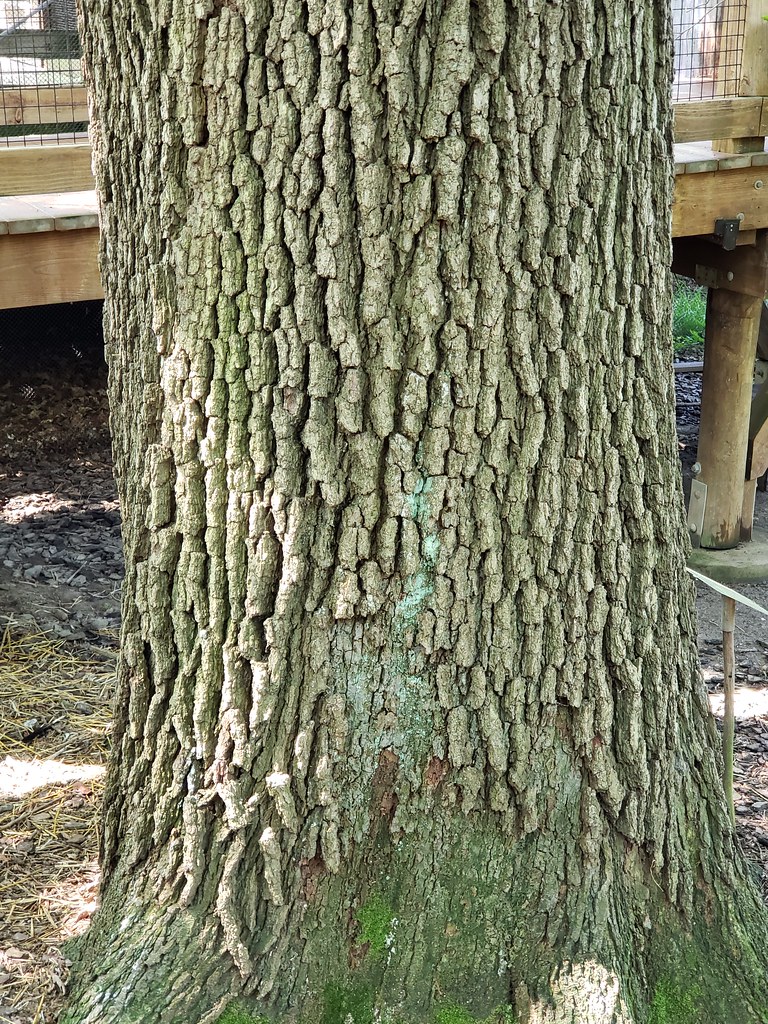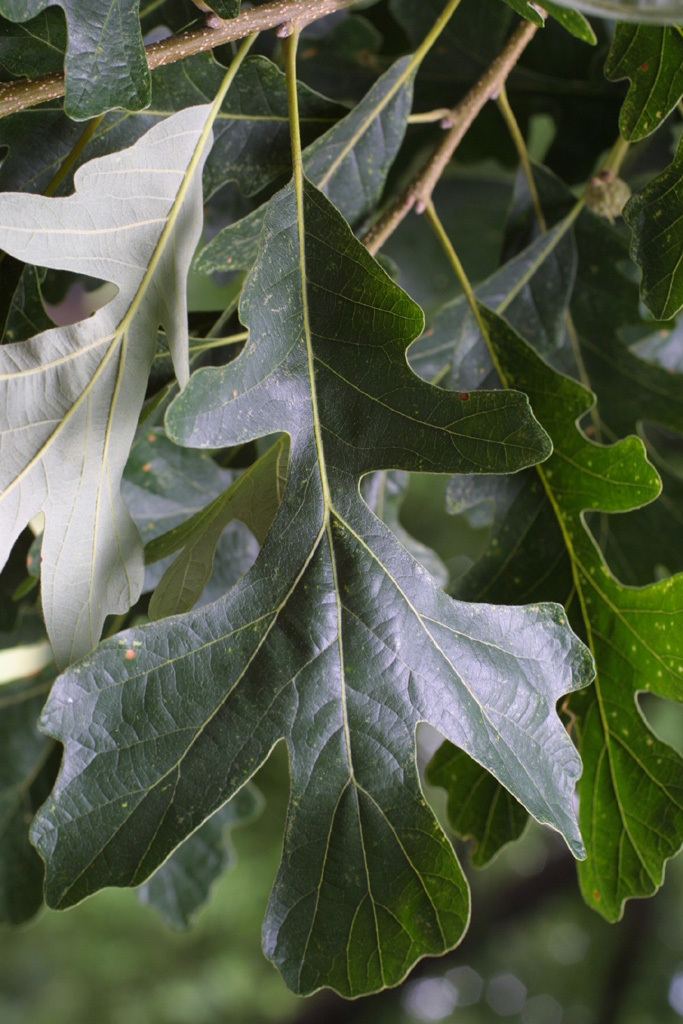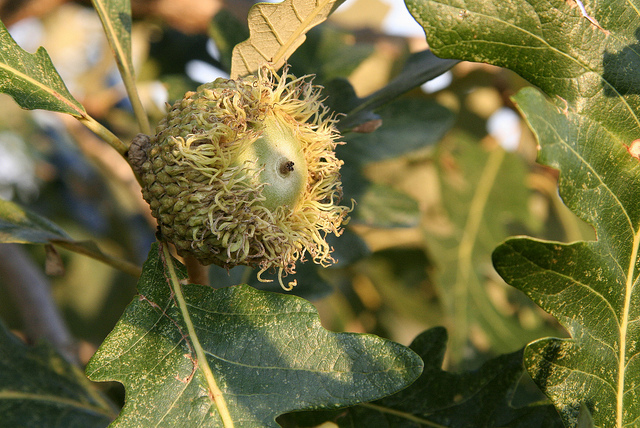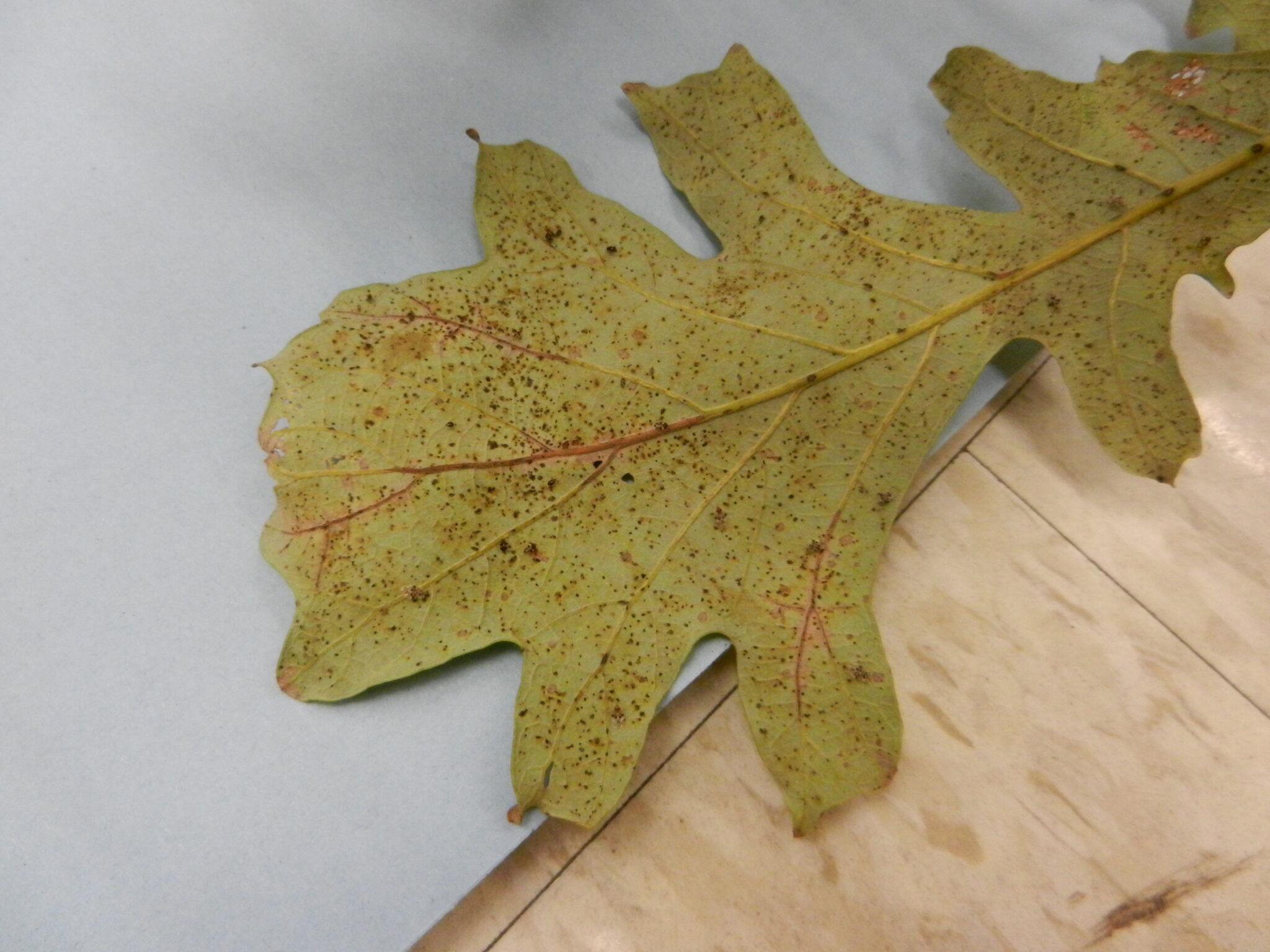Bur oak
Quercus macrocarpa Michx.
Description
Bur oak, also known as mossycup oak or blue oak ², is a member of the beech family (Fagaceae). The tree’s rough bark has deep ridges, and the trunks grow to be very wide³. Bur oaks grow slowly² but can grow to be 70-80 feet tall¹ and can live to be 300-400 years 4. The alternate leaves are 6 to 12 inches long and deeply lobed with 5 to 7 pairs of lobes with a deep incision in the middle. Leaves are widest above the middle. Shallow-lobed leaves may be found on sprouts and deeply shaded branches 4. Leaves may be glaucous (waxy) on the undersurface. They have unique acorns with large, frilly caps that cover at least half of the nut¹. In fact, they have the largest acorns of any native oak² up to 1.5 inches ³.

Bark of bur oak. @ B. Hubick, 2019. Maryland Biodiversity Project 5.
5.
Leaf of bur oak. @ J. Baskauf, 2002. Vanderbilt University 8.
 Acorn of bur oak. @ R. Klips, 2007. Maryland Biodiversity Project 5.
Acorn of bur oak. @ R. Klips, 2007. Maryland Biodiversity Project 5.
Distribution
Bur oaks are mostly found in the mid-west of the United States, but can also be found in southern parts of Canada 4. distribution goes farther north than any other oak tree². In Maryland bur oak is listed as highly state rare 5 and is found in Allegany and Garrett counties². One of the largest bur oaks is in the aviary exhibit at the Maryland Zoo 5. They can survive in areas where annual precipitation is only 15 inches ². These trees are very resilient, as they can tolerate droughts, heat stress, pollution, and sandy, clay, acidic, or alkaline soils¹.

Native range of bur oak. USDA 4.
Wildlife importance
The acorns are eaten by squirrels, mice, white-tailed deer, wood ducks, wild turkeys, rabbits¹, black bears, and goats. Deer will “browse” these trees, or eat the low-hanging leaves, buds, and stems. Red-headed woodpeckers eat the insects that live inside the tree and many birds build their nests in the branches of bur oaks 4. Edwards’ Hairstreak, and Horace’s Duskywing butterfly use bur oak as a larval host ³.
Economic importance
Bur oak wood is sold as “white oak”² which is valuable lumber that can be used for furniture, flooring, and construction. The fine grain of the wood also makes it almost watertight, ideal for making barrels 6.
Threats
Population numbers of bur oaks are threatened in Canada and at the edges of its distribution due to climate change 4. A unique threat this species faces is bur oak blight, which is caused by Tubakia iowensis, a fungus. It causes small, red leaf spots and the major leaf veins die and turn brown, then produce black fungal spores. The leaves will die but stay attached to the stems until next spring. Rain transfers the fungus to other leaves. Infection typically spreads in the spring but symptoms aren’t visible until July. The disease can be controlled with a fungicide treatment7. 
Tubakia infected bur oak leaf. Perdue University 7.
Interesting facts
- Bur oaks are grown purposefully in the prairies of the Midwest to protect houses from wind².
- The acorns can be boiled and ground to make baking flour. Boiled acorns can also be toasted and ground into a coffee substitute³.
- The trees are monoecious, meaning a tree has both male and female reproductive structures³.
- Bur oak begins reproduction at age 35 years and can produce acorns longer than any other oak at 400 years ².
- A bur oak in Sioux City, Iowa is named the Council Oak because Lewis and Clark met with native Americans under it. The tree was already 150 years old back then, making it about 350 years old today¹.
References
- Arbor Day Foundation: Bur oak
- USDA-FS Silvics, Volume 2: Quercus macrocarpa
- Lady Bird Johnson Wildflower Center: Quercus macrocarpa
- USDA_Forest Service, Fire Effects Information System: Quercus macrocarpa
- Maryland Biodiversity Project: Bur oak
- The Morton Arboretum: Bur oak
- Purdue University Landscape Report: Tubakia and bur oak blight
- Vanderbilt University: Quercus macrocarpa
Contributed by M. Lilley
Towson University Glen Arboretum
